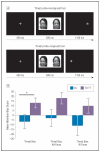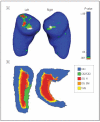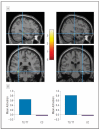FKBP5 and attention bias for threat: associations with hippocampal function and shape
- PMID: 23407841
- PMCID: PMC3732315
- DOI: 10.1001/2013.jamapsychiatry.210
FKBP5 and attention bias for threat: associations with hippocampal function and shape
Abstract
Importance: The FKBP5 gene product regulates glucocorticoid receptor (GR) sensitivity and hypothalamic-pituitary-adrenal axis functioning and has been associated with many stress-related psychiatric disorders. The study of intermediate phenotypes, such as emotion-processing biases and their neural substrates, provides a way to clarify the mechanisms by which FKBP5 dysregulation mediates risk for psychiatric disorders.
Objective: To examine whether allelic variations for a putatively functional single-nucleotide polymorphism associated with FKBP5 gene regulation (rs1360780) would relate differentially to attention bias for threat. this was measured through behavioral response on a dot probe task and hippocampal activation during task performance. Morphologic substrates of differential hippocampal response were also measured.
Design: Cross-sectional study conducted from 2010 to 2012 examining associations between genotype, behavioral response, and neural response (using functional magnetic resonance imaging [fMRI]) on the dot probe; voxel-based morphometry and global and local shape analyses were used to measure structural differences in hippocampi between genotype groups.
Setting: Participants were recruited from primary care clinics of a publicly funded hospital in Atlanta, Georgia.
Participants: An African American cohort of adults (N = 103) was separated into 2 groups by genotype: one genotype group included carriers of the rs1360780 T allele, which has been associated with increased risk for posttraumatic stress disorder and affective disorders; the other group did not carry this allele. Behavioral data included both sexes (N = 103); the MRI cohort (n = 36) included only women.
Main outcome measures: Behavioral and fMRI (blood oxygen level-dependent) response, voxel-based morphometry, and shape analyses.
Results: Carriers of the rs1360780 T allele showed an attention bias toward threat compared with individuals without this allele (F1,90 = 5.19, P = .02). Carriers of this allele demonstrated corresponding increases in hippocampal activation and differences in morphology; global and local shape analyses revealed alterations in hippocampal shape for TT/TC compared with CC genotype groups.
Conclusion: Genetic variants of FKBP5 may be associated with risk for stress-related psychiatric disorders via differential effects on hippocampal structure and function, resulting in altered attention response to perceived threat.
Figures



Similar articles
-
STRUCTURAL AND FUNCTIONAL CONNECTIVITY IN POSTTRAUMATIC STRESS DISORDER: ASSOCIATIONS WITH FKBP5.Depress Anxiety. 2016 Apr;33(4):300-7. doi: 10.1002/da.22483. Depress Anxiety. 2016. PMID: 27038411 Free PMC article.
-
Effect of the common functional FKBP5 variant (rs1360780) on the hypothalamic-pituitary-adrenal axis and peripheral blood gene expression.Psychoneuroendocrinology. 2014 Apr;42:89-97. doi: 10.1016/j.psyneuen.2014.01.007. Epub 2014 Jan 23. Psychoneuroendocrinology. 2014. PMID: 24636505
-
FKBP5 genotype and structural integrity of the posterior cingulum.Neuropsychopharmacology. 2014 Apr;39(5):1206-13. doi: 10.1038/npp.2013.322. Epub 2013 Nov 20. Neuropsychopharmacology. 2014. PMID: 24253961 Free PMC article.
-
The rs1360780 Variant of FKBP5: Genetic Variation, Epigenetic Regulation, and Behavioral Phenotypes.Genes (Basel). 2025 Mar 11;16(3):325. doi: 10.3390/genes16030325. Genes (Basel). 2025. PMID: 40149476 Free PMC article. Review.
-
The role of FKBP5, a co-chaperone of the glucocorticoid receptor in the pathogenesis and therapy of affective and anxiety disorders.Psychoneuroendocrinology. 2009 Dec;34 Suppl 1:S186-95. doi: 10.1016/j.psyneuen.2009.05.021. Psychoneuroendocrinology. 2009. PMID: 19560279 Review.
Cited by
-
Eye tracking indices of attentional bias in children of depressed mothers: Polygenic influences help to clarify previous mixed findings.Dev Psychopathol. 2016 May;28(2):385-97. doi: 10.1017/S0954579415000462. Epub 2015 Jun 1. Dev Psychopathol. 2016. PMID: 26030911 Free PMC article.
-
Structure and function of the TPR-domain immunophilins FKBP51 and FKBP52 in normal physiology and disease.J Cell Biochem. 2024 Dec;125(12):e30406. doi: 10.1002/jcb.30406. Epub 2023 Apr 23. J Cell Biochem. 2024. PMID: 37087733 Review.
-
Psychiatric symptoms in adolescents: FKBP5 genotype--early life adversity interaction effects.Eur Child Adolesc Psychiatry. 2015 Dec;24(12):1473-83. doi: 10.1007/s00787-015-0768-3. Epub 2015 Sep 30. Eur Child Adolesc Psychiatry. 2015. PMID: 26424511
-
The neurophysiological consequences of racism-related stressors in Black Americans.Neurosci Biobehav Rev. 2024 Jun;161:105638. doi: 10.1016/j.neubiorev.2024.105638. Epub 2024 Mar 24. Neurosci Biobehav Rev. 2024. PMID: 38522814 Free PMC article. Review.
-
Genetic Moderation of Stress Effects on Corticolimbic Circuitry.Neuropsychopharmacology. 2016 Jan;41(1):275-96. doi: 10.1038/npp.2015.216. Epub 2015 Jul 20. Neuropsychopharmacology. 2016. PMID: 26189450 Free PMC article. Review.
References
-
- Denny WB, Valentine DL, Reynolds PD, Smith DF, Scammell JG. Squirrel monkey immunophilin FKBP51 is a potent inhibitor of glucocorticoid receptor binding. Endocrinology. 2000;141(11):4107–4113. - PubMed
-
- Binder EB, Bradley RG, Liu W, Epstein MP, Deveau TC, Mercer KB, Tang Y, Gillespie CF, Heim CM, Nemeroff CB, Schwartz AC, Cubells JF, Ressler KJ. Association of FKBP5 polymorphisms and childhood abuse with risk of post-traumatic stress disorder symptoms in adults. JAMA. 2008;299(11):1291–1305. - PMC - PubMed
Publication types
MeSH terms
Substances
Grants and funding
LinkOut - more resources
Full Text Sources
Other Literature Sources
Miscellaneous

